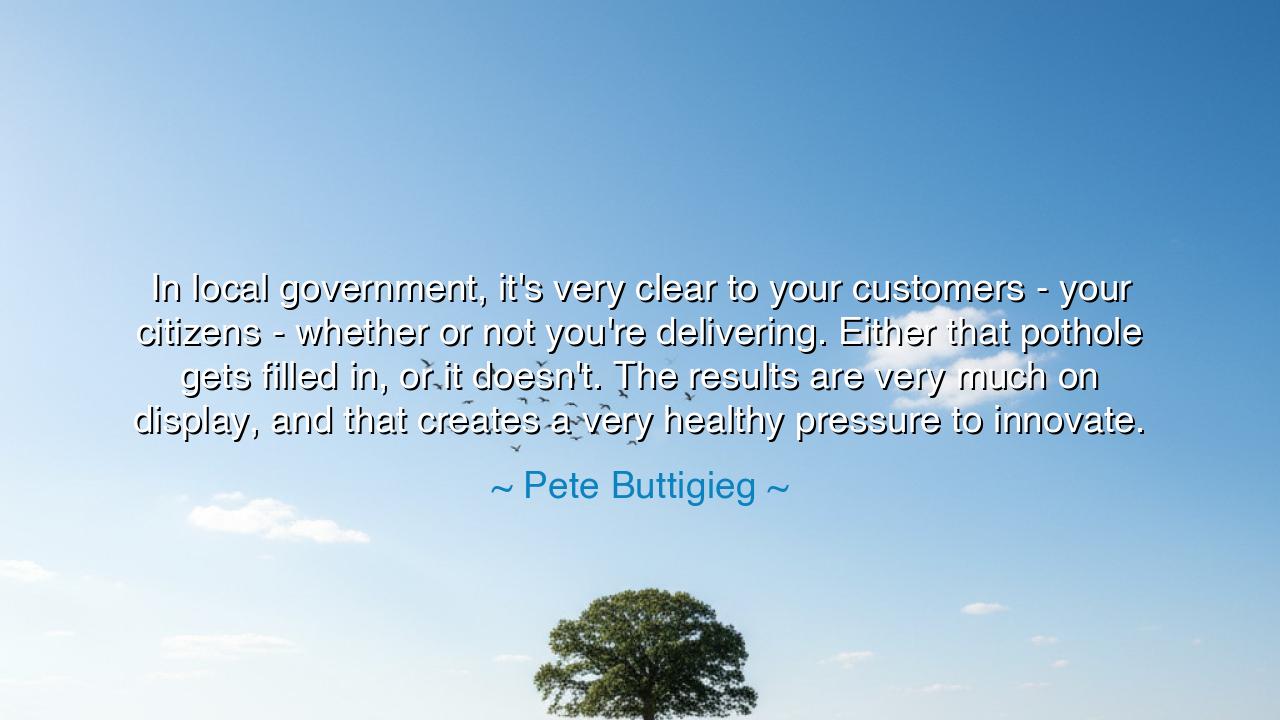
In local government, it's very clear to your customers - your
In local government, it's very clear to your customers - your citizens - whether or not you're delivering. Either that pothole gets filled in, or it doesn't. The results are very much on display, and that creates a very healthy pressure to innovate.






"In local government, it's very clear to your customers – your citizens – whether or not you're delivering. Either that pothole gets filled in, or it doesn't. The results are very much on display, and that creates a very healthy pressure to innovate." – Pete Buttigieg
In these words, Pete Buttigieg, former mayor of South Bend, Indiana, and later a national leader, captures the essence of accountability and innovation in public service. His statement may appear simple, but it carries profound wisdom about leadership, responsibility, and the nature of power. He reminds us that government, at its truest and most human level, is not about distant policies or lofty rhetoric—it is about tangible results that touch the daily lives of people. The filled pothole, the clean street, the working light—these are the visible measures of trust between a government and its people.
The origin of this quote reflects Buttigieg’s experience as a mayor who governed not from marble halls, but from the ground—where citizens could look him in the eye and demand results. In local government, excuses cannot hide failure; progress cannot be proclaimed without proof. There, every success is visible, and every failure stands exposed beneath the sunlight of public life. It is this immediacy of consequence that fuels the “healthy pressure to innovate” of which he speaks. For in such an environment, leaders cannot survive on promises alone—they must deliver.
This principle echoes through the long annals of governance. The ancient city-states of Athens and Rome thrived not because of their size, but because of their civic engagement—citizens could witness the workings of their governments firsthand. In Athens, if a road crumbled or an aqueduct broke, the failure could not be hidden behind layers of bureaucracy; the people saw, the people spoke, and leaders were held to account. Buttigieg’s wisdom thus revives an old truth: that proximity to the people purifies governance. When leaders stand close enough to see the faces of those they serve, corruption fades and innovation blooms.
Buttigieg’s metaphor of the pothole carries a quiet nobility. It reminds us that leadership is not always about grand reforms or sweeping laws—it is often about humble, necessary acts that make life better for others. The leader who fills a pothole shows as much moral integrity as the one who signs a treaty, for both acts spring from the same duty: the care of the community. And it is through such small acts, repeated countless times, that the great fabric of civilization is woven. The visible nature of local governance makes it a forge where competence and character are tested under the gaze of the people.
Consider the story of Fiorello La Guardia, the beloved mayor of New York City during the Great Depression. Known as “the Little Flower,” he personally visited fire scenes, read comic strips over the radio to children during newspaper strikes, and rode along with police officers through the night. His leadership was rooted in presence and action—he filled not only potholes, but also the void of trust that had grown between citizens and government. Like Buttigieg, he understood that when government is near and visible, it must earn legitimacy not through words, but through deeds.
There is also a deeper philosophical current beneath Buttigieg’s words. He implies that transparency and accountability are the soil in which innovation grows. When results are visible and the people’s judgment immediate, there is no room for complacency. Pressure, rightly harnessed, becomes creative energy. It drives improvement, demands efficiency, and nurtures courage. The very visibility of failure becomes the catalyst for success. As in craftsmanship, where every flaw is seen and corrected, so too in governance must every imperfection be confronted, not concealed.
The lesson, then, is timeless: leadership must be both visible and accountable. To lead is to serve in the open, where the eyes of the people become the measure of one’s integrity. Innovation is not born in secrecy, but in the light of scrutiny. When leaders embrace the healthy pressure of responsibility, they become better stewards—not only of their offices but of the trust of those they serve.
And so, the practical actions are these: whatever your sphere—be it governance, business, or personal life—embrace visibility. Let your work be seen and judged. Do not fear criticism; let it sharpen you. Seek feedback not as condemnation, but as counsel. And when faced with the “potholes” of your own life—those visible problems that cannot be ignored—meet them with diligence and humility. For as Pete Buttigieg reminds us, the truest test of leadership is not in the promise of progress, but in the proof of results.






AAdministratorAdministrator
Welcome, honored guests. Please leave a comment, we will respond soon